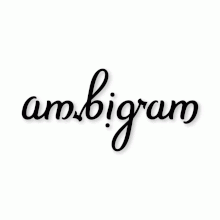
An ambigram is a calligraphic composition of glyphs (letters, numbers, symbols or other shapes) that can yield different meanings depending on the orientation of observation.[2][3] Most ambigrams are visual palindromes that rely on some kind of symmetry, and they can often be interpreted as visual puns.[4] The term was coined by Douglas Hofstadter in 1983–1984.[2][5]
Most often, ambigrams appear as visually symmetrical words. When flipped, they remain unchanged, or they mutate to reveal another meaning. "Half-turn" ambigrams undergo a point reflection (180-degree rotational symmetry) and can be read upside down (for example, the word "swims"), while mirror ambigrams have axial symmetry and can be read through a reflective surface like a mirror. Many other types of ambigrams exist.[6]
Ambigrams can be constructed in various languages and alphabets, and the notion often extends to numbers and other symbols. It is a recent interdisciplinary concept, combining art, literature, mathematics, cognition, and optical illusions. Drawing symmetrical words constitutes also a recreational activity for amateurs. Numerous ambigram logos are famous, and ambigram tattoos have become increasingly popular. There are methods to design an ambigram, a field in which some artists have become specialists.
- ^ Cepelewicz, Jordana (2020-02-12). "New Clues About 'Ambigram' Viruses With Strange Reversible Genes". Quanta Magazine. Archived from the original on 2021-09-17. Retrieved 17 November 2021.
- ^ a b Cite error: The named reference
AmbigramMeriamWebsterwas invoked but never defined (see the help page). - ^ Cite error: The named reference
EuronewsScrabblewas invoked but never defined (see the help page). - ^ Cite error: The named reference
polsterwas invoked but never defined (see the help page). - ^ Cite error: The named reference
HofstadterIndianawas invoked but never defined (see the help page). - ^ "Ambigram". Oxford English Dictionary. Archived from the original on 2023-07-25. Retrieved 2023-07-25.